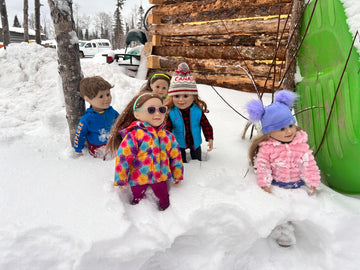Plus de deux ans de recherches approfondies ont été nécessaires pour créer Saila, la fille Maplelea qui partage son héritage inuit. Dans notre quête pour créer un personnage qui serait le reflet fidèle d'une fille de 10 ans qui grandit à Iqaluit aujourd'hui, nous avons recherché de nombreuses sources d'information.

Nous avons participé à la célébration du 10e anniversaire de la création du territoire du Nunavut à Ottawa, assisté à un séminaire de sensibilisation aux Inuits, consulté de nombreuses personnes-ressources et lu abondamment des documents en ligne et imprimés. Ensuite, la présidente Kathryn Gallagher Morton et sa famille se sont rendues à Iqaluit où elles ont passé dix jours à faire connaissance avec la ville et ses habitants. Elles ont goûté à des plats traditionnels du pays, participé aux Jeux de Noël, séjourné dans une maison locale, observé un sculpteur de pierre au travail, discuté avec des artisans lors d’une exposition d’artisanat locale, assisté à un service religieux bilingue (anglais et inuktitut), visité une école et d’autres installations et organismes communautaires, visité les édifices du Parlement et discuté avec beaucoup de gens très sympathiques.
Kathryn a rencontré des familles de Maplelea et leur a demandé leurs idées et suggestions pour ce nouveau personnage. En assistant aux Jeux de Noël qui se déroulaient dans une salle locale pendant plusieurs soirées, Kathryn a eu l’occasion d’interviewer personnellement un certain nombre de filles qui ont partagé avec elle leurs histoires sur ce que c’est que d’être une jeune fille qui grandit au Nunavut aujourd’hui.
 Nous avons demandé à notre artiste canadienne de sculpter la nouvelle poupée et, en nous basant sur les informations que nous avions recueillies, nous avons créé une garde-robe et des accessoires pour elle. Le journal a été écrit et illustré, puis traduit en français et en inuktitut.
Nous avons demandé à notre artiste canadienne de sculpter la nouvelle poupée et, en nous basant sur les informations que nous avions recueillies, nous avons créé une garde-robe et des accessoires pour elle. Le journal a été écrit et illustré, puis traduit en français et en inuktitut.
Nous avons recherché des installations de production au Nunavut et avons été ravis de conclure un contrat avec le Centre Uqqurmiut pour les arts et l'artisanat à Pangnirtung pour produire un chapeau Pang pour Saila, ainsi qu'avec Kiluk Ltd. à Arviat pour produire un amauti pour elle.

Nous voulions que Saila soit un modèle intéressant, authentique et positif, non seulement pour les filles d’origine inuite vivant au Nunavut, mais pour toutes les filles vivant dans toutes les régions du Canada. Nous pensons y être parvenus. Nous espérons que vous serez d’accord.
Nous tenons à remercier toutes les filles, les familles et les membres de la communauté du Nunavut qui ont partagé avec tant d'ouverture et de gentillesse leurs histoires et leurs expériences, dont seules quelques-unes sont présentées ici. Ces informations ont été extrêmement utiles à la création de notre personnage Saila Qilavvaq.






Saila is one of the most beautiful dolls I’ve ever seen! If I may ask, what is the name of the Canadian artist who designed her face sculpt? He or she deserves so much credit! :)
I love Saila!! I have given her as a gift.
I would love it if you would create an indigenous doll from BC’s West Coast. From the Shishálh Nation!! Like my niece.
ALOHA, I used Saila Saari to represent the Hawaiian Islands in a display for my final project at Brigham Young University-Hawaii on the Island of Oahu. I had tried more local dolls but my Hawaiian friends immediately chose Saila for her beautifully sculpted face; especially the graceful elegance in her smile. I have had 2 Saila dolls which have been passed on to friends who have expressed their admiration for the doll. I am now saving up for another. I have owned more than 10 Maplelea dolls most of which I donated to the daughters of Students at the university after I completed my display of the Pa’u riders of Hawaii. I want to say MAHALO (which means thank you in Hawaiian) for your commitment to doll making.
Love Saila!!! I went to the showroom three years ago with considering another character. But once I saw her… it was love at first sight! The hair, the face mold, the skin tone and reading the exhibit about the care put into making her so authentic. I just had to get her! My daughter is still young but we keep taking the doll down of the display for her to play and cuddle. I am really proud of this product and what she represents (and this from the point of view of a new Canadian coming from a totally different background). Please, I want to see more of her stories, her outfit and more articles about the making of the other dolls. These backstories and details is what make these dolls so attractive (at least to me).
How do you pronounce Saila’s first and last names? It would be wonderful if you could ask one of the young Inuit girls to make an audiofile with the correct pronounciation!
Our Saila just came to live with us today—Christmas Day—and the recipients cried when they saw a doll that looked like them (we are PNWC First Nations). They keep stroking her face and comparing her skin to their own, her face to theirs, with awe and delight! I cannot thank you enough for this beautiful, so-well researched doll.